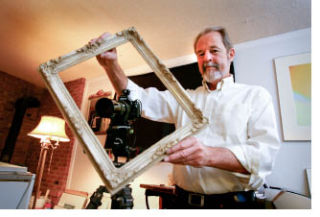Mark Lovejoy isn’t trying to freak his viewers out.
“Not startle, per se, but the work is more offbeat than a lot of photography, for better or worse,” he said.
Lovejoy’s showing of surreal, weird, unexpected, and just plain manipulated photographs, a collection aptly titled “Photographs Strange and Different,” will be on display at Arts Studio beginning June 7.
Lovejoy used to shoot and print straightforward work – portraits, gardens – and aspired to Ansel-Adams-like sharpness in his images.
But after a time, he found that the work wasn’t stirring his creative juices. It wasn’t so much the subjects, but the end result of pure representation.
“I actually got bored with the idea that as a photographer, you were just recording what was already there,” he said.
At the same time, Lovejoy found himself uninterested in the pursuit of perfection. Call it creative spark or, as he puts it, fundamental laziness. All he knew was that he wanted to start blurring the lines between art and reality, and embracing imperfection.
So in the studio, in other spots around the house, around town, and out in the field, Lovejoy began shooting still lifes and accompanying environment scenes, playing around using different light sources, exposures, and layers of images. He wanted to see what could happen if he just… let things happen.
Lovejoy’s primary pieces of equipment are a Nikon 8008 35 mm camera he’s had for years, a refurbished Macintosh G4 that he procured for $350, and a photo printer.
The monitor is old-school, and while he admits that he’d like a flat-screen model, his lack of cutting-edge technology doesn’t hamper him. The trusty tools, with the sometime use of a good old Xerox machine, are his friends.
After shooting, often randomly – he once amassed 200 rolls of film and started developing them out of order – the development process is one of experimentation as he lets different mixtures of solution do their mysterious work on the film’s emulsion.
Sometimes, an image will turn completely abstract. And sometimes, he says, the emulsion degrades in a magical fashion that complements the original image in a way he could never have anticipated.
“One of the things I love to see is the way images deteriorate the more and more you do with them,” he said. “It’s unpredictable, which is one of the things I love about this process…you almost always end up with something different.”
Lovejoy scans his resulting prints digitally and further manipulates them on the computer before printing.
Subjects can come from anywhere. He’s turned two diminutive Norwegian Christmas dolls into trippy, acid-washed visions of spirituality and togetherness. A Japanese Geisha doll, who usually sits in the living room cabinet with the Norwegian pair, in print has become a dappled tapestry.
An alien-esque eye, the white turned green and blue and the surrounding face flaky gray-white, was shot directly from the television screen, then “distressed” as he described.
He’s also shot from newspaper images and magazines. At times, as in a series of color fields hanging on his living room walls, he shoots with no subject at all. And sometimes he even just drops film into developing solution to see what will transpire. Paintings inspire him; Jackson Pollack, the Abstract Expressionists and Pop Art all inform his work.
Lovejoy says time and time again, the two questions people always ask about his work are “How did you do that?” and “Just what is that, anyway?”
He’ll never tell. Even if he could.
“To me, the real question is, is the image interesting in and of itself? If I can’t remember what it was, then it’s a good thing.”



